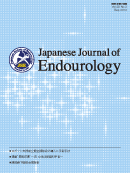Current issue
Displaying 1-38 of 38 articles from this issue
- |<
- <
- 1
- >
- >|
-
2021 Volume 34 Issue 2 Pages 177
Published: 2021
Released on J-STAGE: December 01, 2021
Download PDF (1317K) -
2021 Volume 34 Issue 2 Pages 178-181
Published: 2021
Released on J-STAGE: December 01, 2021
Download PDF (15605K) -
2021 Volume 34 Issue 2 Pages 182-185
Published: 2021
Released on J-STAGE: December 01, 2021
Download PDF (1560K) -
2021 Volume 34 Issue 2 Pages 186-190
Published: 2021
Released on J-STAGE: December 01, 2021
Download PDF (28018K) -
2021 Volume 34 Issue 2 Pages 191-195
Published: 2021
Released on J-STAGE: December 01, 2021
Download PDF (39269K)
-
2021 Volume 34 Issue 2 Pages 196
Published: 2021
Released on J-STAGE: December 01, 2021
Download PDF (1201K) -
2021 Volume 34 Issue 2 Pages 197-200
Published: 2021
Released on J-STAGE: December 01, 2021
Download PDF (4304K) -
2021 Volume 34 Issue 2 Pages 201-204
Published: 2021
Released on J-STAGE: December 01, 2021
Download PDF (3201K) -
2021 Volume 34 Issue 2 Pages 205-210
Published: 2021
Released on J-STAGE: December 01, 2021
Download PDF (1589K) -
2021 Volume 34 Issue 2 Pages 211-215
Published: 2021
Released on J-STAGE: December 01, 2021
Download PDF (2983K)
-
2021 Volume 34 Issue 2 Pages 216
Published: 2021
Released on J-STAGE: December 01, 2021
Download PDF (1201K) -
2021 Volume 34 Issue 2 Pages 217-220
Published: 2021
Released on J-STAGE: December 01, 2021
Download PDF (31611K) -
2021 Volume 34 Issue 2 Pages 221-225
Published: 2021
Released on J-STAGE: December 01, 2021
Download PDF (1538K) -
2021 Volume 34 Issue 2 Pages 226-230
Published: 2021
Released on J-STAGE: December 01, 2021
Download PDF (1887K) -
2021 Volume 34 Issue 2 Pages 231-236
Published: 2021
Released on J-STAGE: December 01, 2021
Download PDF (30812K)
-
2021 Volume 34 Issue 2 Pages 237
Published: 2021
Released on J-STAGE: December 01, 2021
Download PDF (1317K) -
2021 Volume 34 Issue 2 Pages 238-242
Published: 2021
Released on J-STAGE: December 01, 2021
Download PDF (4882K) -
2021 Volume 34 Issue 2 Pages 243-245
Published: 2021
Released on J-STAGE: December 01, 2021
Download PDF (1691K) -
2021 Volume 34 Issue 2 Pages 246-251
Published: 2021
Released on J-STAGE: December 01, 2021
Download PDF (18616K) -
2021 Volume 34 Issue 2 Pages 252-255
Published: 2021
Released on J-STAGE: December 01, 2021
Download PDF (2059K)
-
2021 Volume 34 Issue 2 Pages 256-260
Published: 2021
Released on J-STAGE: December 01, 2021
Download PDF (1488K) -
2021 Volume 34 Issue 2 Pages 261-267
Published: 2021
Released on J-STAGE: December 01, 2021
Download PDF (17645K) -
2021 Volume 34 Issue 2 Pages 268-273
Published: 2021
Released on J-STAGE: December 01, 2021
Download PDF (1507K)
-
2021 Volume 34 Issue 2 Pages 274-279
Published: 2021
Released on J-STAGE: December 01, 2021
Download PDF (43483K) -
2021 Volume 34 Issue 2 Pages 280-286
Published: 2021
Released on J-STAGE: December 01, 2021
Download PDF (6877K)
-
2021 Volume 34 Issue 2 Pages 287-294
Published: 2021
Released on J-STAGE: December 01, 2021
Download PDF (3709K) -
2021 Volume 34 Issue 2 Pages 295-299
Published: 2021
Released on J-STAGE: December 01, 2021
Download PDF (1987K) -
2021 Volume 34 Issue 2 Pages 300-306
Published: 2021
Released on J-STAGE: December 01, 2021
Download PDF (2032K) -
2021 Volume 34 Issue 2 Pages 307-312
Published: 2021
Released on J-STAGE: December 01, 2021
Download PDF (10207K) -
2021 Volume 34 Issue 2 Pages 313-317
Published: 2021
Released on J-STAGE: December 01, 2021
Download PDF (3074K) -
2021 Volume 34 Issue 2 Pages 318-322
Published: 2021
Released on J-STAGE: December 01, 2021
Download PDF (68057K) -
2021 Volume 34 Issue 2 Pages 323-327
Published: 2021
Released on J-STAGE: December 01, 2021
Download PDF (9008K) -
2021 Volume 34 Issue 2 Pages 328-334
Published: 2021
Released on J-STAGE: December 01, 2021
Download PDF (33959K) -
2021 Volume 34 Issue 2 Pages 335-341
Published: 2021
Released on J-STAGE: December 01, 2021
Download PDF (2702K) -
2021 Volume 34 Issue 2 Pages 342-349
Published: 2021
Released on J-STAGE: December 01, 2021
Download PDF (5303K)
-
2021 Volume 34 Issue 2 Pages 350-355
Published: 2021
Released on J-STAGE: December 01, 2021
Download PDF (2451K) -
2021 Volume 34 Issue 2 Pages 356-361
Published: 2021
Released on J-STAGE: December 01, 2021
Download PDF (4470K) -
2021 Volume 34 Issue 2 Pages 362-366
Published: 2021
Released on J-STAGE: December 01, 2021
Download PDF (2534K)
- |<
- <
- 1
- >
- >|
